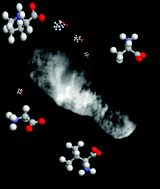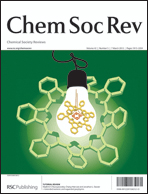Prebiotic chemistry in icy grain mantles in space. An experimental and observational approach†
Abstract
A compendium of different solid carbonaceous materials detected in space is presented, focussing on the search for organic matter of prebiotic interest. This journey takes us from the carbon grains likely formed in the atmospheres of evolved stars to organic grain mantles made from ice processing thought to be present in dense interstellar clouds and circumstellar regions, making a stop in solar system objects that could have delivered organic species to the early Earth. The most abundant carbon materials detected to date in space appear to be of little biological relevance. On the other hand, organic refractory residues, made in the laboratory from UV-photoprocessing followed by warm-up of interstellar ice analogs, are a


 Please wait while we load your content...
Please wait while we load your content...